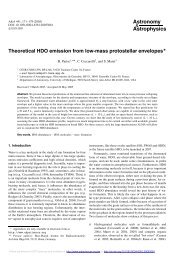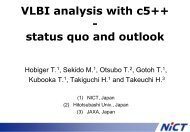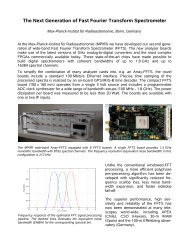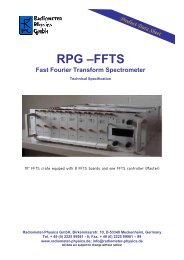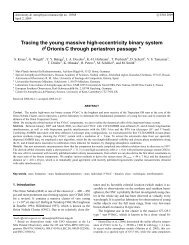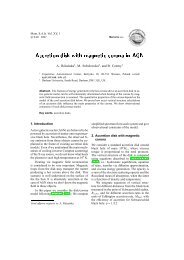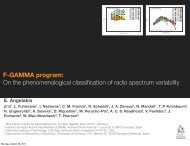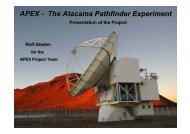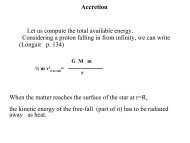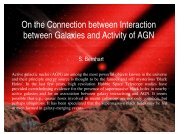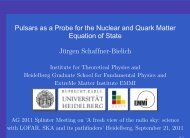Interstellar Chemistry - Mpifr-bonn.mpg.de
Interstellar Chemistry - Mpifr-bonn.mpg.de
Interstellar Chemistry - Mpifr-bonn.mpg.de
- No tags were found...
You also want an ePaper? Increase the reach of your titles
YUMPU automatically turns print PDFs into web optimized ePapers that Google loves.
<strong>Interstellar</strong> <strong>Chemistry</strong>COFormal<strong>de</strong>hy<strong>de</strong> (H 2CO)Methanol CH 3OHC 3H 2Benzene (C 6H 6)Peter Schilke
Overview●why interstellar chemistry is different●types of gas phase chemical reactions●<strong>de</strong>uterium fractionation●chemical networks●example calculations●dust surface chemistry●PDR/XDR/CDR chemistry●shock chemistryPeter Schilke
<strong>Interstellar</strong> chemistry is differentChemical reactions on earthA + B → AB* (excited state, unstable, lifetime 10 -12 s)followed byAB* → AB + C + ∆E kinthe collision with a third particle C within the lifetime of AB* isnee<strong>de</strong>d to remove excess energy, otherwise the reactionAB* → A + Bwill occur. Due to momentum conservation, the excess energycannot be converted into kinetic energy.Peter Schilke
In space, the <strong>de</strong>nsity is so low that no particle C will come by withinthe lifetime of AB*, so only reactions of the typeA + B → C + DorA + B → AB + hνare possible. The second reaction product allows to obey energy- andmomentum conservation laws.Also, at temperatures between 10 and 300 K most endothermic reactionscannot occur since not enough energy is available.In space, we have a low-energy, two-body-in two-body-out chemistry.The reaction rates are of no interest to terrestrial chemistry and oftenare only guestimates.Peter Schilke
Types of reactions:A + crp → A + + e cosmic ray ionization ζ = 10 -17 s -1A + + BC → AB + + C ion-neutral reaction 10 -9 cm 3 s -1A + + B → A + B + charge transfer reaction 10 -9 cm 3 s -1 for energy resonance(similar ionization potentialsfor A and B)very low otherwiseA + BC → AB + C neutral-neutral reaction 10 -11 cm 3 s -1A + B → AB + hν radiative association 10 -17 cm 3 s -1A + + e → A + hν radiative recombination 10 -12 cm 3 s -1AB + + e → A + B dissociative recombination 10 -6 cm 3 s -1Peter Schilke
Why the different rates?IA + + BC → AB + + C ion-neutral reaction 10 -9 cm 3 s -1ion polarizes neutral (produces attractive 1/r 2 potential)A + BC → AB + C neutral-neutral reaction 10 -11 cm 3 s -1van <strong>de</strong>r Waals attractive 1/r 6 potential (but often barriers or activationenergies - very difficult to <strong>de</strong>termine either experimentally or theoretically)Peter SchilkeAB + + e → A + B dissociative recombination 10 -6 cm 3 s -1Coulomb 1/r potential
Why elementary quantum physics was not wasted:<strong>de</strong>uterium fractionationE vib = k v 1 2 ⇒ [XD]/[XH] = 1000 [D]/[H]Peter Schilke
Ion-neutral chemistry is most effective - how to get ionsstart: ionization by cosmic rays:+H 2+ e (88%)H 2+ crp → H + + H + e (2%)2H (10%)followed byH 2++ H 2→ H 3++ HH 3+is the most important ion which starts most other reactionsPeter Schilke
Oxygen chemistry is started either byH + + O → H + O + + 227 Kwhich works because the ionization potentials of H and O are almosti<strong>de</strong>ntical (resonance),orH 3++ O → OH + + H 2followed byO + + H 2→ OH + + Ha typical, very common hydrogen abstraction reactionOH + + H 2H 2O + + H 2→ H 2O + + H→ H 3O + + Hfollowed byH 2O + + e→ OH + HH 3O + + e → H 2O + HPeter Schilke
Carbon chemical networkin the presence ofphoto-chemistryPeter Schilke
Time-<strong>de</strong>pen<strong>de</strong>nt calculations starting from atomic initial conditionsConsi<strong>de</strong>r time scales – chemistry has a memoryPeter Schilke
●molecules do freeze out on dust surfaces●increased reaction times (not just fly-by)●Grain is third particle to take up excess energy and momentum●Dust surface chemistryReactions like A + B → AB are possible●tunneling of reaction barriers●reaction potentials differed by being bound to surfaces●lighter atoms can move around by tunneling or thermal hopping●Peter Schilke
Dust surface chemistry● leads to hydrogenation of molecules● only way to produce H 2● only efficient way to produce H 2CO, CH 3OH●question how to release molecules into gas phasePeter Schilke
HChallenge:Formation of HydrogenHH 2++ eH 2dustparticleCosmicrayO
Grains in Diffuse & Dense CloudsPAH’sDiffuseDense0.1 µmSilicate andcarbonaceoussurfaces; size dist.goes as r -3.5Mantle of ices<strong>de</strong>veloping by surfacechemistry and accretion
Peter Schilke<strong>Interstellar</strong> Dust
Freeze-out chemistry
Depletion
Peter SchilkeDust chemistry
Peter SchilkeDust surface chemistry
p +H 2 OC O HCO H 2 CO~ 10 KOHOHCH 3 OH H HCH 2 OHCH 3 OHCO 2H 2 CO 3HCOOHHCOOHOCH 2 CH 2 OHEthylene Glycol
HOH HC C HH OHHOHCHHCOEthylene GlycolGlycolal<strong>de</strong>hy<strong>de</strong>Discovered in 2002 in the ISM& in Comet Hale-Bopp in2004!(Hollis et al., 2000)(Crovisier et al., 2004)Discovered in the ISM in2000(Hollis et al., 2002)
How does it get OFF?●●●●Thermal <strong>de</strong>sorptionSputtering in shocksCosmic ray hits (spot heating)X-ray or UV● Chemical energy of reaction (H 2)Peter Schilke
Desorption of CO on Water IceCO on differentsurfaces:GoldIce, adsorption atdifferent temperatures
CO on Water Ice160 KWater ice <strong>de</strong>sorbs, remaining CO is released135 - 140 KWater ice crystallizes and opens pathwaysfor CO, some of which <strong>de</strong>sorbsTemperature30 - 70 KCO is trapped in pores by phase changeof water ice; surface CO <strong>de</strong>sorbs10 - 20 KDiffusion of solid CO into pores< 10 KAdsorption of CO layer on amorphousH 2O surfaceM. P. Collings, H. J. Fraser, J. W. Dever, M. R. S. McCoustra and D. A. WilliamsAp. J., 2003, 583, 1058-1062
Peter SchilkeIce spectra
Hot cores
Peter SchilkeAll this leads to spectra like this...
Molecules in space (10/2005)2 Atome 3 Atome 4 Atome 5 Atome 6 Atome 7 Atome 8 Atome 9 Atome 10 Atome 11 Atome 12 Atome 13 AtomeH2 C3 c-C3H C5 C5H C6H CH3C3N CH3C4H CH3C5N HC9N C6H6 HC11NAlF C2H l-C3H C4H l-H2C4 CH2CHCN HCOOCH3 CH3CH2CN (CH3)2COAlCl C2O C3N C4Si C2H4 CH3C2H CH3COOH (CH3)2O (CH2OH)2 (?)C2 C2S C3O l-C3H2 CH3CN HC5N C7H CH3CH2OH H2NCH2COOH (?)CH CH2 C3S c-C3H2 CH3NC CH3CHO H2C6 HC7N CH3CH2CHOCH + HCN C2H2 CH2CN CH3OH CH3NH2 CH2OHCHO C8HCN HCO NH3 CH4 CH3SH c-C2H4O l-HC6H (?)CO HCO + HCCN HC3N HC3NH + H2CCHOH CH2CHCHO (?)CO + HCS + HNCH + HC2NC HC2CHOCP HOC + HNCO HCOOH NH2CHOSiC H 2O HNCS H2CNH C5NHCl H 2S HOCO + H2C2O l-HC4HKCl HNC H2CO H2NCN l-HC4NNH HNO H2CN HNC3NO MgCN H2CS SiH4NS MgNC H3O + H2COH +NaCl N2H + c-SiC3OH N2O C3HPNSOSO +SiNSiOSiSNaCNOCSSO2c-SiC2CO2NH2CS H3 +HF H2D + , D2H +SHHDFeO (?)SiCNAlNCSiNCO2 (?)CF +
<strong>Chemistry</strong> in hot places●hot cores (T = 100-300 K)Peter Schilke●grain mantles released●somewhat endothermic reactions possible●PDRs [XDRs, CDRs] (T up to a few thousand K and photons)●photon chemistry (dissociation) possible●high-T chemistry●shocks (T up to a few thousand K)●●high-T chemistry●in magnetohydrodynamic shocks relative motions of ions(including charged grains) and neutrals●●different energies available for ion-neutral and neutralneutralreactionsgrain mantle and even grain core sputtering
Peter SchilkeSchematic PDR:mo<strong>de</strong>ls require knowledge ofchemistryradiative transferinteractions (self-shielding of H 2and CO)
Shielding and self-shielding●●●Molecules are dissociated by UV photonsThey can be shiel<strong>de</strong>d by dustH 2can self-shield● CO can self-shield and be shiel<strong>de</strong>d by H 2Peter Schilke
H 2self-shieldingUVPeter Schilke
Peter SchilkeCO shielding by H 2
Peter SchilkeMost prominent PDR: Orion Bar
Hydrogen chemistry in a PDR mo<strong>de</strong>l for the Orion BarUV radiationPeter Schilke
Carbon chemistry in a PDR mo<strong>de</strong>l for the Orion BarUV radiationPeter Schilke
Peter SchilkePDR heating
Peter SchilkePDR cooling
Shocks in the ISM:● J-shocks (jump shocks)● very high temperatures(10,000 K)● dissociative● molecule reformation in postshockgas● cooling by molecular radiation● C-shocks ("continuous"shocks)● in presence of magnetic fields● broad shocks with mo<strong>de</strong>ratetemperatures (100-1000 K)● ambipolar diffusion in shockPeter Schilke
Sources of shocks●●●●●Interaction of Supernova-Remnants withmolecular cloudsMolecular outflowsExpanding ionization frontsSpiral <strong>de</strong>nsity wavesCloud-cloud collisions– Colliding galaxies (starbursts)– Orbit crossing (barred galaxies, e.g. Milky Way)Peter Schilke
Peter SchilkeTemperatures and velocities in a C-shock (30 km/s)
Water production in shock by neutral-neutral reactions initiated byO + H 2+ 2980 K → OH + HOH + H 2+ 1490 K → H 2O + HPeter Schilke
Shock chemistry



